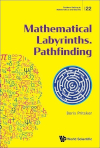- About MAA
- Membership
- MAA Publications
- Periodicals
- Blogs
- MAA Book Series
- MAA Press (an imprint of the AMS)
- MAA Notes
- MAA Reviews
- Mathematical Communication
- Information for Libraries
- Author Resources
- Advertise with MAA
- Meetings
- Competitions
- Programs
- Communities
- MAA Sections
- SIGMAA
- MAA Connect
- Students
- MAA Awards
- Awards Booklets
- Writing Awards
- Teaching Awards
- Service Awards
- Research Awards
- Lecture Awards
- Putnam Competition Individual and Team Winners
- D. E. Shaw Group AMC 8 Awards & Certificates
- Maryam Mirzakhani AMC 10 A Awards & Certificates
- Two Sigma AMC 10 B Awards & Certificates
- Jane Street AMC 12 A Awards & Certificates
- Akamai AMC 12 B Awards & Certificates
- High School Teachers
- News
You are here
Mathematical Labyrinths. Pathfinding

Publisher:
World Scientific
Publication Date:
2021
Number of Pages:
324
Format:
Hardcover
Series:
Problem Solving in Mathematics and Beyond
Price:
88.00
ISBN:
978-9811228230
Category:
Problem Book
[Reviewed by , on ]
Steve Benson
12/27/2021
This volume, the 22nd entry of World Scientific’s Problem Solving in Mathematics and Beyond series, will serve as an excellent resource for mathematics teachers, coaches of problem-solving teams, and anyone else who enjoys puzzling over clever problems, providing useful additions to a reader’s problem-solving toolkit.
The book focuses on reasoning and problem analysis and contains many useful suggestions for approaching challenging problems as well as nice philosophical passages on the process of problem-solving, so the reader who merely scans for a particular problem or solution will miss out on helpful strategies and philosophy included in the narrative. Organized into 11 chapters by problem-solving style/techniques, some of the chapters include relatively well-known problem types, but most contain problems or solutions that were new to this reviewer. In particular, one chapter contains a number of clever problems designed to elicit (implicit or explicit) false assumptions while another includes the familiar “river crossing” problems, but also introduces the card game preferans, popular in the former Soviet republics and Eastern Europe. Another unique problem type involves Slyboots (in the familiar universe of Liars and Truthtellers, Slyboots alternatively lie and tell the truth).
A chapter featuring geometric transformation opens with an apt quote from Pólya’s How to Solve It: “(I)f general education intends to bestow on the student the idea of a logical system, it must reserve a place for geometric proofs.” While many problem books shy away from geometric proof and problem-solving, this one has a number of chapters and a lot of challenging and illustrative problems, including those involving isometric and homothetic geometric transformations and restricted or inaccessible vertex constructions, with the only prerequisite being familiarity with basic straightedge and compass constructions.
Of course, books such as this one cannot possibly include every problem or even every solution to a given problem. While it is easy for an “expert” to bemoan the omission of a particular pet problem or alternate solution or leaving out what seem like details in a particular solution, the author does an admirable job of providing multiple solutions to many problems, while explaining the motivation for the solutions - one of the chapters specifically focuses on (and highlights the usefulness of) solutions that don’t use symbolic algebra. Acknowledging the impossibility of satisfying everyone, it would have been useful if this approach had spilled over into more sections of the book as a number of opportunities to share non-symbolic - especially visual - solutions were missed.
While the book could have benefited from more careful editing - there are a number of typographical errors and the author’s idiosyncratic style of language could cause difficulties, especially for less experienced readers of technical mathematics - the author’s narrative style provides a welcome, engaging personalization to the material and his enthusiasm is evident. Reading this book feels very much like an enjoyable discussion with a colleague or teacher.
Steve Benson is a Professor of Mathematics at Lesley University and co-Director of the Master of Science for Teachers program at the University of New Hampshire. He received his Ph.D. in Mathematics from the University of Illinois under the supervision of Dr. Leon R. McCulloh.
See the publisher's website.
- Log in to post comments




